Quants Menu
- HCF and LCM
- Number System
- Number Decimals & Fractions
- Surds and Indices
- Divisibility
- Ages
- LCM
- HCF
- Inverse
- Speed Time and Distance
- Work and Time
- Boats and Streams
- Pipes and Cisterns
- Averages
- Allegations and Mixtures
- Ratio and Proportions
- Simple & Compound Interest
- Simple Interest
- Compound Interest
- Percentages
- Profit & Loss
- Successive Discount 1
- Successive Discount 2
- AP GP HP
- Arithmetic Progressions
- Geometric Progressions
- Harmonic Progressions
- Probability
- Permutation & Combination
- Combination
- Circular Permutation
- Geometry
- Heights and Distances
- Perimeter Area and Volume
- Coordinate Geometry
- Venn Diagrams
- Set Theory
- Algebra
- Linear Equations
- Quadratic Equations
- Logarithms
- Clocks
- Calendars
- Clocks and Calendars
- Finding remainder of large powers
PREPINSTA PRIME
Formulas for Set Theory
Set theory and its Formula
Set theory is a branch of mathematical logic that studies sets, which informally are collections of objects. Although any type of object can be collected into a set, set theory is applied most often to objects that are relevant to mathematics. Formulas for Set Theory are very useful in terms of exams.
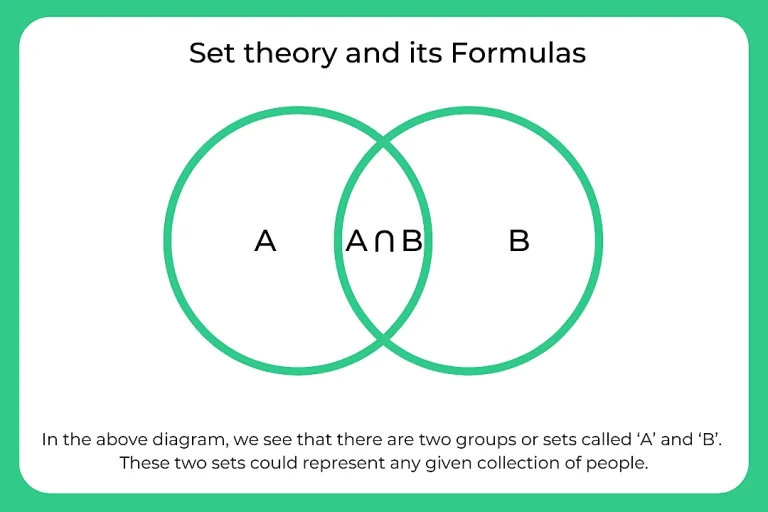
Formulas for Set Theory
Notations used in set theory:
- n(A) – Cardinal number of set A.
- n∘(A) – Cardinality of set A.
- \overline{A} = Ac – complement of set A.
- U – Universal
- A ⊂ B – Set A is proper subset of subset of B.
- A ⊆ B – Set A is subset of set B.
- ∅ – Null set.
- a ∈ A – element “a” belongs to set A.
- A ∪ B – union of set A and set B.
- A ∩ B – intersection of set A and set B.
Formulas
- If A and B are overlapping set, n(A ∪ B) = n(A) + n(B) – n(A ∩ B).
- If A and B are disjoint set, n(A ∪ B) = n(A) + n(B).
- n(A) = n(A ∪ B) + n(A ∩ B) – n(B).
- n(A ∩ B) = n(A) + n(B) – n(A ∪ B).
- n(B) = n(A ∪ B) + n(A ∩ B) – n(A).
- n(U) = n(A) + n(B) – n(A ∩ B) + n((A ∪ B)c).
- n((A ∪ B)c) = n(U) + n(A ∩ B) – n(A) – n(B).
- n(A ∪ B) = n(A – B) + n(B – A) + n(A ∩ B).
- n(A – B) = n(A ∪ B) – n(B).
- n(A – B) = n(A) – n(A ∩ B).
- n(Ac) = n(U)- n(A)
Get PrepInsta Prime & get Access to all 200+ courses offered by PrepInsta in One Subscription
Some Examples based On Above Formulas:
Question 1: If A = { 1, 4, 5, 8} and B = { 6, 8, 10, 12}. Find A ∩ B.
Answer: A∩B= {8}
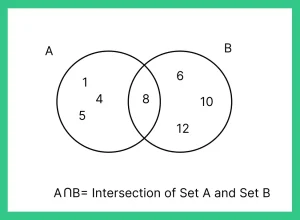
Question 2: Check whether A={8,7,6,9} and B={9,6,7,8} are equal sets?
Answer: Yes they are equal sets since all the elements of A are present In B.
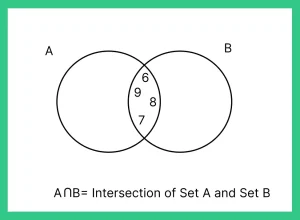
Question 3: If A= { 7,8,0,6,8} B = { 5,6,7,8,9,0} Find A-B and B-A?
Answer: A-B= Elements in set a but not in b = { } null:
B-A= Elements in set b but not in a= {5, 9}.
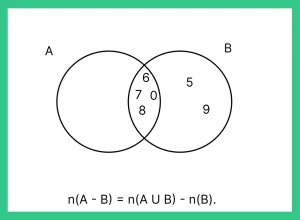
Question 4:If A={1,2,3,4} B={3,5,6,9} and C={6,7,8,9} Find A∩(B ∪ C).
Answer: B ∪ C = {6,9}, A∩(B ∪ C) = { } null, as there is no element in common
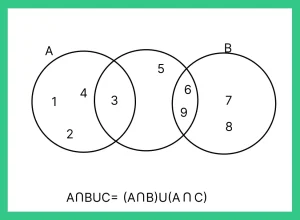
Question 5: If U={ 1,2,3,4,5,6,7,8,9} A= {2,4,6} Find A’.
Answer: A’ means all the elements except that in A. {1,3,5,7,8,9}
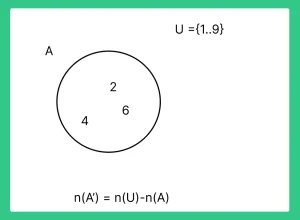
Also Check Out
Get over 200+ course One Subscription
Courses like AI/ML, Cloud Computing, Ethical Hacking, C, C++, Java, Python, DSA (All Languages), Competitive Coding (All Languages), TCS, Infosys, Wipro, Amazon, DBMS, SQL and others
- Geometry – Questions | Formulas | How to Solve Quickly | Tricks & Shortcuts
- Heights and Distances – Questions | Formulas | How to Solve Quickly | Tricks & Shortcuts
- Perimeter Area and Volume – Questions | Formulas | How to Solve Quickly | Tricks & Shortcuts
- Coordinate Geometry – Questions | Formulas | How to Solve Quickly | Tricks & Shortcuts
- Venn Diagrams – Questions | Formulas | How to Solve Quickly | Tricks & Shortcuts
- Geometry – Questions |
Formulas |
How to Solve Quickly |
Tricks & Shortcuts - Heights and Distances –
Questions |
Formulas |
How to Solve Quickly |
Tricks & Shortcuts - Perimeter Area and Volume – Questions |
Formulas |
How to Solve Quickly |
Tricks & Shortcuts - Coordinate Geometry –
Questions |
Formulas |
How to Solve Quickly |
Tricks & Shortcuts - Venn Diagrams – Questions |
Formulas |
How to Solve Quickly |
Tricks & Shortcuts

 Apply For Jobs
Apply For Jobs Get Hiring Updates
Get Hiring Updates




Login/Signup to comment